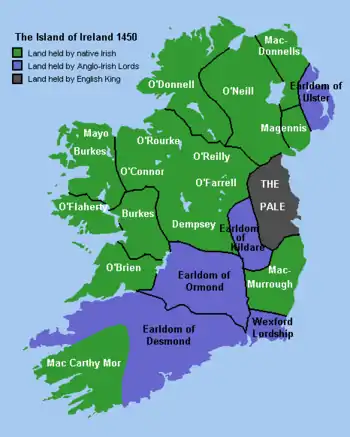Maurice FitzGerald | |
|---|---|
| Earl of Desmond | |
 Statue of Maurice Fitzgerald inside Desmond Castle, Kinsale | |
| Tenure | 1487–1520 |
| Predecessor | Thomas FitzJames FitzGerald |
| Successor | James FitzMaurice FitzGerald |
| Other names | Vehiculus, Bellicosus |
| Died | 1520 |
| Buried | Tralee |
| Nationality | Hiberno-Norman |
| Spouse(s) | Ellen Roche Honora Fitzgibbon |
| Issue | Thomas FitzMaurice FitzGerald James FitzMaurice FitzGerald Joan FitzGerald Ellis FitzGerald |
| Parents | Thomas FitzJames FitzGerald Ellice de Barry |
Maurice FitzGerald, 9th Earl of Desmond (died 1520) was the brother of James FitzGerald, 8th Earl of Desmond.[1]
Life

Upon the murder of James FitzThomas FitzGerald, the 8th Earl of Desmond, in 1487, his brother Maurice, called Baccagh, or The Lame,[2] became the 9th Earl of Desmond. The murderer, John Murtagh was apprehended and put to death.[3] In 1489 a plague ravaged the country, followed by a famine in 1497, and many died.[4]
According to Alfred Webb: "Being lame, and usually carried in a horse-litter, he was styled 'Vehiculus,' and by some, on account of his bravery, 'Bellicosus.'"[5]
In 1495, Maurice FitzThomas FitzGerald supported the pretender, Perkin Warbeck, in the Siege of Waterford and other expeditions. Nevertheless, making a humble submission, King Henry VII not only forgave, but took him into favour, 26 August 1497, and granted him all the 'customs, pockets, poundage, and prize-wines of Limerick, Cork, Kingsale, Baltimore, and Youghall, with other privileges and advantages.'
About the year 1500, Maurice FitzGerald rebuilt Desmond Castle, a three-story tower house in the town of Kinsale, to serve as a Customs House for wine and gunpowder.
"The condition of the inhabitants within the Pale at this period is thus described by a contemporary writer: 'What with the extortion of coyne and lyverye dayly, and wyth the wrongful exaction of osteing money, and of carryage and cartage dayly, and what with the Kinge's great subsydye yerely, and with the said trybute, and blak-rent to the Kinge's Iryshe enymyes, and other infynyt extortions, and dayly exactions, all the Englyshe folke of the countys of Dublyn, Kyldare, Meathe, and Uryell ben more oppressyd with than any other folke of this land, Englyshe or Iryshe, and of worsse condition be they athysside than in the marcheis.' O'Daly thus writes of Earl Maurice: 'This man was subsequently far famed for his martial exploits. He augmented his power and possessions — for all his sympathies were English — and a furious scourge was he to the Irish, who never ceased to rebel against the crown of England. The bitterest enemy of the Geraldines he made his prisoner, to wit, MacCarthy Mor, Lord of Muskerry; and now having passed thirty years opulent, powerful, and dreaded, he died [1520] to the sorrow of his friends and the exultation of his enemies.' He was buried at Tralee. His first wife was daughter of Lord Fermoy; his second, daughter of the White Knight."[5]
Marriage and issue

Maurice first married Ellen,[7] daughter of Maurice Roche, 2nd Lord of Fermoy (distantly related to the Barons Fermoy), and his wife Lady Joan FitzGerald, daughter of James FitzGerald, 8th Earl of Desmond, and had issue:
- Thomas FitzMaurice, who predeceased his father, leaving behind one daughter[7]
- James FitzGerald, 10th Earl of Desmond[7]
- Joan, who married Cormac Óg MacCarthy[7]
- Ellis, who married Connor O'Brien, King of Thomond[7]
Maurice's second wife was Honora, daughter of the White Knight.[7]
| Ancestors of Maurice FitzGerald, 9th Earl of Desmond | |||||||||||||||||||||||||||||||||||||||||||||||||||||||||||||||||||||||||||||||||||||||||||||||||||||||||||||||||||||||||||||||||||||||||||||||||||||||||||||||||||||||||||||||||||||||||||||||||||||||||||||||||||||||||||||||||||||||||||||||||||||||||||||||||||||||||||||||||||||||||||||||||||||||||||||||||||||||||||||||||||||||||||||||||||||||||||||||||||||||||||||||||||||||||||||||||||||||||||||||||||||||||||||||||||||||||||||||||||||||||||||||||||||||||||||||||||||||||||||||||||||||||||||||||||||||||||||||||||||||||||||||||||||||||||||
|---|---|---|---|---|---|---|---|---|---|---|---|---|---|---|---|---|---|---|---|---|---|---|---|---|---|---|---|---|---|---|---|---|---|---|---|---|---|---|---|---|---|---|---|---|---|---|---|---|---|---|---|---|---|---|---|---|---|---|---|---|---|---|---|---|---|---|---|---|---|---|---|---|---|---|---|---|---|---|---|---|---|---|---|---|---|---|---|---|---|---|---|---|---|---|---|---|---|---|---|---|---|---|---|---|---|---|---|---|---|---|---|---|---|---|---|---|---|---|---|---|---|---|---|---|---|---|---|---|---|---|---|---|---|---|---|---|---|---|---|---|---|---|---|---|---|---|---|---|---|---|---|---|---|---|---|---|---|---|---|---|---|---|---|---|---|---|---|---|---|---|---|---|---|---|---|---|---|---|---|---|---|---|---|---|---|---|---|---|---|---|---|---|---|---|---|---|---|---|---|---|---|---|---|---|---|---|---|---|---|---|---|---|---|---|---|---|---|---|---|---|---|---|---|---|---|---|---|---|---|---|---|---|---|---|---|---|---|---|---|---|---|---|---|---|---|---|---|---|---|---|---|---|---|---|---|---|---|---|---|---|---|---|---|---|---|---|---|---|---|---|---|---|---|---|---|---|---|---|---|---|---|---|---|---|---|---|---|---|---|---|---|---|---|---|---|---|---|---|---|---|---|---|---|---|---|---|---|---|---|---|---|---|---|---|---|---|---|---|---|---|---|---|---|---|---|---|---|---|---|---|---|---|---|---|---|---|---|---|---|---|---|---|---|---|---|---|---|---|---|---|---|---|---|---|---|---|---|---|---|---|---|---|---|---|---|---|---|---|---|---|---|---|---|---|---|---|---|---|---|---|---|---|---|---|---|---|---|---|---|---|---|---|---|---|---|---|---|---|---|---|---|---|---|---|---|---|---|---|---|---|---|---|---|---|---|---|---|---|---|---|---|---|---|---|---|---|---|---|---|---|---|---|---|---|---|---|---|---|---|---|---|---|---|---|---|---|---|---|---|---|---|---|---|---|---|---|---|---|---|---|---|---|---|---|---|---|---|---|---|---|---|---|---|---|---|---|---|---|---|---|---|---|---|---|---|---|---|---|---|---|---|---|---|---|---|---|---|---|---|---|---|---|---|---|---|---|---|---|---|---|---|---|---|---|---|---|---|---|---|---|---|---|---|---|---|---|---|---|---|---|---|---|---|---|---|---|---|---|---|---|---|
| |||||||||||||||||||||||||||||||||||||||||||||||||||||||||||||||||||||||||||||||||||||||||||||||||||||||||||||||||||||||||||||||||||||||||||||||||||||||||||||||||||||||||||||||||||||||||||||||||||||||||||||||||||||||||||||||||||||||||||||||||||||||||||||||||||||||||||||||||||||||||||||||||||||||||||||||||||||||||||||||||||||||||||||||||||||||||||||||||||||||||||||||||||||||||||||||||||||||||||||||||||||||||||||||||||||||||||||||||||||||||||||||||||||||||||||||||||||||||||||||||||||||||||||||||||||||||||||||||||||||||||||||||||||||||||||
References
- ↑ Cokayne, George Edward, Complete Peerage of England, Scotland, Ireland, Great Britain and the United Kingdom, Extant, Extinct, or Dormant. Volume III. London: George Bell & Sons. 1890. p. 83
- ↑ No. 2. The Earls of Desmond, ed. James Graves. The Journal of the Historical and Archaeological Association of Ireland, Third Series, Vol. 1, No. 2 (1869), pp. 459-498 (60 pages). Page 465. Accessed 20 August 2023.
- ↑ Connellan, Owen. The Annals of Ireland [from A.D. 1171 to A.D. 1616, Dublin. Brian Geraghty, 1846, p. 312
 This article incorporates text from this source, which is in the public domain.
This article incorporates text from this source, which is in the public domain. - ↑ Connellan, p. 335.
- 1 2 Webb, Alfred. A Compendium of Irish Biography. Dublin: 1878.
- ↑ "Reginald Tower (Closed at present for essential maintenance)".
- 1 2 3 4 5 6 Burke, Bernard, A Genealogical History of the Dormant, Abeyant, Forfeited, and Extinct Peerages of the British Empire. London: Harrison. 1866. p. 205